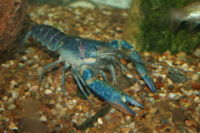Redclaw Crayfish (Cherax quadricarinatus)
From The Aquarium Wiki
Redclaw Crayfish
Cherax quadricarinatus
95 Litres (25 US G.)
17.8-20.3cm (7-8 ")
Freshwater
7.2 - 7.8
12.8-35°C (55 -95 °F)
10-50 °d
1:1 M:F
3-12 years
This animal is available captive bred
Contents
Alternative names[edit]
- Redclaw Crayfish, Blue Lobster, Australian Crayfish
Origin[edit]
- This species is native to freshwater creeks and water bodies in tropical Queensland, the Northern Territory and south-eastern Papua New Guinea. It has been widely translocated around the world, and is considered an invasive species. This species has established feral populations in South Africa, Mexico, Jamaica and Puerto Rico (Ahyong and Yeo 2007). This species has a distribution exceeding 3.5 million km2.
Sexing[edit]
- The adult male gets a distinctive red patch on the outside of his claws, this is absent on females. On the rare "blues" from Cherax Park, Au. the red stripe is replaced with a translucent white on the males. The male is also larger than the female, reaching a maximum of 25 cm in length and weight up to 600g.
Tank compatibility[edit]
- They are a bottom dweller and will eat anything they come across, as they are opportunistic eaters. It is not advisable to keep this species in the same aquarium as aquatic frogs or snails as these are easy prey for this species. If they can catch passing fish, these will also be eaten. Moreover, they can be very aggressive and will often attack smaller species of crayfish. Even fish that are too large for them to devour, will nevertheless face violence from them. Ideally they're best kept in single species tanks only. Plants will be uprooted & eaten. Sunken wood will also be consumed.
Diet[edit]
- Redclaw are omnivorous with a diet that includes small invertebrates and aquatic plants. They will act as a scavenger in the aquarium, eating any food that comes to rest on the bottom. Supplement their diet with a quality sinking pellet, flake food and dried algae. Gum tree bark is easily sunk, & will disappear quickly. Frozen peas are also a favorite. Being omnivorous,they also prey on other aquatic organisms. They will eat dying or dead fish. Brine shrimp, tubifex worms, and bloodworms will also work.
Feeding regime[edit]
- Feed once or twice a day - supplementing when necessary.
Environment Specifics[edit]
- In their native range, Redclaw inhabit a diversity of freshwater habitats including still ponds, small creeks, isolated rock pools and fast flowing rivers. Although native to tropical and subtropical bioregions, they can tolerate a broad temperature range, low dissolved oxygen concentrations and crowded conditions. Plenty of cover should be included in the aquarium, including both rocks and plants (Although the plants will not last long as the cray gets larger). After moulting the crayfish is vulnerable to attack and consumption by others.
- If the exuvia (shed exoskeleton) is removed from the tank after shedding, the crayfish will likely die as this shed will be consumed for vital calcium. If your water has enough calcium in it this will not be an issue however.
Behaviour[edit]
- They do not burrow as much as other species. They will dig out under rocks & enlarge holes where possible. In their natural habitat, redclaw are a relatively non-aggressive, non-burrowing species. However, observation of introduced populations and within the aquarium trade, indicate that this species can display aggressiveness and burrowing habits. The females are territorial when with eggs. A larger aquarium will be needed if housing more than one. Provide at least 80 Litres (21.1US G.) per Cray and include plenty of cover including both rocks and plants. Fights are common, often resulting in loss of limbs, especially as the water gets warmer.
Identification[edit]
- Generally they are blue to a blue/brown/green colour. Because of their selective breeding in the hobby, they will not change to their original colouration, except in times of stress or when feed or housed incorrectly. The blue colour seems to intensify when the water is clean, and be more green/brown when left in brackish water.
